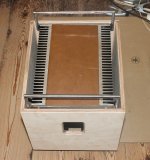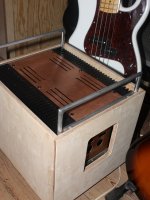hi everybody.have any body tried to paint heatsinks?i was thinking to paint amplifier heatsinks with high temperature spray used to paint vehicle exhausts.do you guys think it will work?should i use a primer before?
thanks.
thanks.
They don't get that hot, normal paint is fine. But you will need etching or epoxy primer otherwise the paint will just flake off because of the alloy material.
Painting them can decrease their emissivity.
From a table I saw a long time ago "black oil varnish" had the highest emissivity on the table...better than plain...if I remember correctly.
There will be more information about this on "the net" now...Mr Google knows all. 🙂
From a table I saw a long time ago "black oil varnish" had the highest emissivity on the table...better than plain...if I remember correctly.
There will be more information about this on "the net" now...Mr Google knows all. 🙂
Thick paint might decrease effective emissivity, by adding an insulating layer. Thin paint should be fine.
they don't get that hot but i already have the paint so why not?the heatsinks are huge so even if they loose some dissipation ability i will still be fine.
You'll need to clean and degrease them VERY well first, maybe even sandblast them so surface is a little rough.
Aluminum is hard to paint, try to find an anodizer, which is the standard heatsink finish.
Ultra thin and tough.
Aluminum is hard to paint, try to find an anodizer, which is the standard heatsink finish.
Ultra thin and tough.
Have you thought about DIY anodising them ? There is a wealth of information on the net about it.
Painting heat sinks....a big NO..NO!!!
BINGO!!!!! You just hit the nail right on the head😉
Long time ago I made that mistake painting my heatsinks black to match the chassis....BIG MISTAKE!😱 I had to scrape all the paint off. and YES..it will DECREASE the heat transfer.
Painting them can decrease their emissivity.
From a table I saw a long time ago "black oil varnish" had the highest emissivity on the table...better than plain...if I remember correctly.
There will be more information about this on "the net" now...Mr Google knows all. 🙂
BINGO!!!!! You just hit the nail right on the head😉
Long time ago I made that mistake painting my heatsinks black to match the chassis....BIG MISTAKE!😱 I had to scrape all the paint off. and YES..it will DECREASE the heat transfer.
Practically any type of paint will be better than bright aluminium regarding emissivity, including the ones that look rather light-colored: for far IR, which is what matters, most pigments and dyes appear black.BINGO!!!!! You just hit the nail right on the head😉
Long time ago I made that mistake painting my heatsinks black to match the chassis....BIG MISTAKE!😱 I had to scrape all the paint off. and YES..it will DECREASE the heat transfer.
In theory the conductivity could matter, but in practice, with the thickness of the layer, the exchange surface and the thermal conductivity of organic polymers, the increase in thermal resistance will be modest. This means that in at least 90% of the situations, any type of paint will be preferable to bright aluminium.
Anodization or special paints are of course (slightly) better
Practically any type of paint will be better than bright aluminium regarding emissivity, including the ones that look rather light-colored: for far IR, which is what matters, most pigments and dyes appear black.
In theory the conductivity could matter, but in practice, with the thickness of the layer, the exchange surface and the thermal conductivity of organic polymers, the increase in thermal resistance will be modest. This means that in at least 90% of the situations, any type of paint will be preferable to bright aluminium.
Anodization or special paints are of course (slightly) better
well this is new.
anyway i will use sandpaper to make them rough i will use primer and then paint.i believe i will have a sucess since i was planing for two pairs of mosfet but know i will use one one so they are more than enough.
the only problem the paint will not degrade after some time.
and the surface that "conducts" the heat to the moving air flow must not be an effective insulator.
Conduction through the "finish" is VERY important.
Anodise is a very good conductor. The thickness of anodise makes the finish a better than a very good conductor.
I saw an estimate of 8% of the total finned heatsink dissipation is by radiation. I would not mind losing much or most of that 8%, if I knew that I was not ruining the conduction of the other 92% that still needs to be dissipated.
Conduction through the "finish" is VERY important.
Anodise is a very good conductor. The thickness of anodise makes the finish a better than a very good conductor.
I saw an estimate of 8% of the total finned heatsink dissipation is by radiation. I would not mind losing much or most of that 8%, if I knew that I was not ruining the conduction of the other 92% that still needs to be dissipated.
Black oxide is a better finish than anodise, thinner and more conductive but it's not something you can do in the kitchen at home.
http://www.birchwoodtechnologies.com/news/5283.html
http://www.birchwoodtechnologies.com/news/5283.html
Last edited:
Conrad heatsinks
Conrad heatsinks, a part mentioned and used by a number of DIY audio members, use a powder coated paint finish and they seem to work just fine.
I use fast drying flat black laquer from a spray can.
Conrad heatsinks, a part mentioned and used by a number of DIY audio members, use a powder coated paint finish and they seem to work just fine.
I use fast drying flat black laquer from a spray can.
I assume you want a consistant looking finish and this is the reason for painting?
While I think its a bad idea and trying to get a good even coat down into the deeper sections will not look right (if it,s a deep finned one).. A better idea would be bead blasting of even sand blasting if you want a new look.
Anodizing is the way to bring it all home
While I think its a bad idea and trying to get a good even coat down into the deeper sections will not look right (if it,s a deep finned one).. A better idea would be bead blasting of even sand blasting if you want a new look.
Anodizing is the way to bring it all home
I did not see it mentioned: Where is the sink located? If it is inside a box, in the dark, it does not matter what colour it is, only the surface area is of importance. E
Lye, Sodium Hydroxide does a pretty good job of degreasing and etching the surface of aluminum.
You need to wash it very thoroughly afterwards.
Automotive sources have "self etching" paints and primers - but they are not thin.
I am very very surprised that Conrad uses a powder coat on heatsinks - a link to a discussion their site regarding that finish would be appreciated, especially what derating they apply. They may have specs for degC/W coated and uncoated that can be compared?
I'd not paint unless and until some specs emerge or other measurements.
_-_-
You need to wash it very thoroughly afterwards.
Automotive sources have "self etching" paints and primers - but they are not thin.
I am very very surprised that Conrad uses a powder coat on heatsinks - a link to a discussion their site regarding that finish would be appreciated, especially what derating they apply. They may have specs for degC/W coated and uncoated that can be compared?
I'd not paint unless and until some specs emerge or other measurements.
_-_-
Conrad Heatsinks - Technical Details
Component Mounting Surface
Heatsink showing linished surface
Conrad heatsink showing machined
and linished surface.
The component mounting surfaces on Conrad heatsinks are machined, generally linished and remain uncoated. This surface preparation maximizes thermal conductivity between component and heatsink by:
Removing the relatively thick, thermally insulating surface oxide layer, formed as a result of any hot forming process with aluminium products.
Providing a flat, smooth surface ensuring maximum surface area contact between component and heatsink.
Keeping the junction between component and heatsink free of any thermally insulating coating.
sounds like they say a hard surface compromises heat transfer
Component Mounting Surface
Heatsink showing linished surface
Conrad heatsink showing machined
and linished surface.
The component mounting surfaces on Conrad heatsinks are machined, generally linished and remain uncoated. This surface preparation maximizes thermal conductivity between component and heatsink by:
Removing the relatively thick, thermally insulating surface oxide layer, formed as a result of any hot forming process with aluminium products.
Providing a flat, smooth surface ensuring maximum surface area contact between component and heatsink.
Keeping the junction between component and heatsink free of any thermally insulating coating.
sounds like they say a hard surface compromises heat transfer
- Status
- Not open for further replies.
- Home
- Design & Build
- Construction Tips
- paint heatsinks

